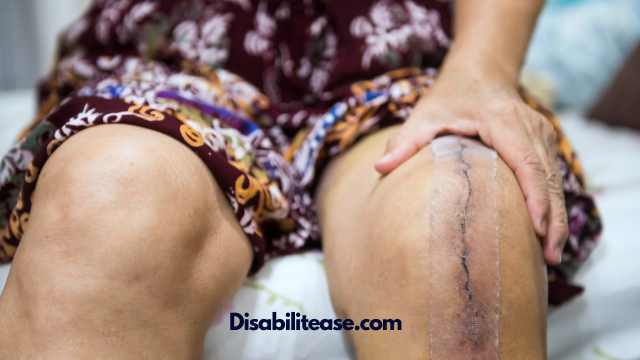Can Arthritis return after knee replacement? Let’s find out. Arthritis is a broad term that is used for several joint diseases. Arthritis is inflammation of the joint and the cartilaginous part lining the bone.
Also, arthritis can attack any joint of the body, but primarily it attacks the knee, hand, and elbows. With Arthritis, the patient can experience pain, stiffness, and reduced joint mobility.

Here is a related article that might interest you on Best Handguns for Seniors and Arthritis Patients for Home & Self-Defense.
Knee joint replacement surgery is one of the most popular, successful, and frequently done in the orthopedic world.
However, in the case of Arthritis, it can be an essential part of the management but cannot cure Arthritis fully. It might come back, although the progression is delayed.
Table of Contents
Can Arthritis Return After Knee Replacement? What Is Knee Arthritis?
Knee arthritis is a pretty cunning condition in our population, and its number is also rising. The knee joint is produced between three bones femur, tibia, and patella. The articular cartilage between these bones disintegrates over time or due to any pathology. This is usually diagnosed with the help of an X-ray.
As the regular lubrication and gliding movement between bones is lost. There is the feeling of stiffness and pain that keeps on increasing, especially if you do some exercise or walk the extra mile. It interferes with daily routine activities, and this is the reason why people choose to undergo knee replacement surgeries.
Knee Replacement As A Last Resort For Arthritis
Arthritis is initially prescribed by medical treatments and some physical therapies and exercises. There is no 100% cure for Arthritis, proven at least medically. The surgical procedure has proven effective for some individuals and even worse for others. It might provide temporary relief, but arthritis return sooner or later.
Knee replacement is the last option for Arthritis, and usually, they need surgical amendments after a few years.
Role Of Knee Surgery In Arthritis
Knee surgery can be done partially or permanently; it depends on the age and how much the bone is affected. It will not provide a permanent solution, but it will temporarily give relief from pain and will still need to be managed medically.
Maintaining a healthy diet, exercising, and following up with doctors and therapists are essential to keep surgery benefits going as long as possible.
Preoperative
Before surgery, some factors need to be determined. What is the age of the person? Is the problem anatomical or not? Is the joint involved entire or not? There are many surgical options for joints, such as osteotomy.
Some investigations that need to be done before surgery are stated below:

- X-rays for misalignments and loosen-up connections.
- Bone scan.
- MRI for soft tissue injuries
- Fluoroscopy for evaluation of ligaments.
- Laboratory investigations:
- ESR for inflammation
- CRP test shows elevated markers of infection and inflammation.
- Arthrocentesis for WBCS, Gram staining, and cultures.
Not every case of osteoarthritis will need a knee joint replacement recommendation by physicians. Though, they have preferably advised all other forms of treatment fail for the patient.
In a study in 2019 in England, 40% of women and 26% of men aged over 50 lived with Arthritis, while in the United States, there were 30% of women and 20% of men diagnosed with Arthritis.
Does Arthritis Come Back After Knee Replacement?
The rise in knee replacement surgery has doubled from 1999-to 2008, with almost 3.5 million surgeries per year expected till 2030. This shows that they might not be able to cure Arthritis entirely but give promising results such as relief from pain, better mobility, and people can resume their daily activities.
According to statistics in Canada, from 2019 to 2020, 32 thousand knee replacement procedures only occurred in Ontario. In contrast, 25 thousand procedures occurred in Switzerland. In OECD countries, 250 procedures per 100,000 populations.
Total knee replacement:
- This surgery goes back to 1968 and has improved technique and reliability. This has helped many patients to get back to their everyday life activities. New surgical techniques, improved implant designs, and construction techniques have made total knee surgery one of the most successful and frequently performed orthopedic procedures.
- The demand for total knee replacement has increased because, despite aging, people prefer to remain active rather than sit on their rocking chairs all day, like in old times. Almost 270,000 total knee replacements are done each year in the United States.
- Patients choose the surgery sometimes mainly and solely because of excruciating pain, and their physician counsels them that this surgery is not the treatment but rather part of the management. Patients are guided that the pain might come back sooner or later.
- The advantage of total knee replacement is that the whole joint is removed and replaced by a prosthetic hence, the part suffering from Arthritis is removed, which decreases the chance of recurrence. However, the chance always remains and so is assisted by medical management to keep the advantages of surgery for as long as possible.
- According to the American Academy of Orthopedic Surgeons, total knee replacement dramatically improves the patient’s life. The procedure is cost-effective and also cuts down the long-term expenditure on treatment. The surgery itself is cost-efficient when compared with pharmacological interventions overall. The knee replacement also improves the range of mobility and reliefs pain.
- Today, the estimated number of people living in the USA with total knee replacement is more than 4.5 million Americans, according to the U. S. National Institutes of Health’s National Institute of Arthritis and Musculoskeletal and Skin Diseases.
- Around half of the prosthetic knees go through radiographic osteoarthritis. It’s mild in the beginning and progresses over 4 years; also stated by Arthritis Care and research that the surgery doesn’t cure Arthritis. The surgery corrects the damage done by Arthritis, and as stated before, the pain is cured. This reduces swelling and delays the destruction of joints.
- Another reason the arthritis returns after years is because of the synovium that grows back and takes several years to grow back so that the problem can occur again.
- Prosthesis implanted anywhere in the body can become a pool of infection. Unfortunately, people with knee joint implants can also have septic Arthritis, which can cause even minor pain and fever. The swelling may take months or sometimes even years to develop. This can be managed with the help of medicines; if it worsens, surgery must be done.
- The above statistic shows That Canadians had a revision of knee implant surgeries for several reasons in 2012-2013 and 2019-2020. This included 36% of patella procedures solely.
Partial Knee Replacement
This is usually performed in young patients who require mobile to live their lives. Arthritis can occur as early as 30 or even be juvenile; This age is when a person needs to be most active, and being operated on at a young age means you will require revisions of surgery once, twice, or even more in your life depending on circumstances.
In such cases, an osteotomy is a good option for young patients. Only the arthritic part of the bone is removed, and the rest is realigned. It targets one compartment at a time.
This has the advantage that the patient’s knee joint is retained, so chances of radiographic osteoarthritis and septic arthritis are reduced; the patient can live pain-free and usually for an extended period, whereas a longer rehabilitation process will be required in such cases.
Also, you have to check out my post on Can Arthritis Turn Into Bone Cancer?
Secondly, although the arthritic bone is removed and replaced by a prosthetic joint, the chances f developing arthritis remains, especially when even a tiny fragment of arthritic bone is left behind.
After Surgery
A flare of symptoms can be seen after surgery. This is because routine medicines are withdrawn or altered to reduce the chance of infection after surgery but can cause a rebound flare.
Conclusion:
Knee joint replacement surgery is one of the most popular, successful, and frequently done in the orthopedic world. However, in the case of Arthritis, it can be an essential part of the management but cannot cure Arthritis fully. It might come back, although the progression is delayed.
In young patients, many revision surgeries may be required to maintain the long-lasting effects of the surgery. Patients need to understand that getting a knee arthroplasty and arthrocentesis doesn’t mean they can live carefreely; even after surgery, you need to be on medication, although they are pretty minor.
Also, a person needs a healthy diet, exercise, and maintain weight, so less pressure is exerted on joints.

Hi, my name is Eddie, I am a professional trainer specializing in the elderly population and I’m also a website designer. I love training in the gym, going to the beach, traveling, and having good food.
I combined my love for sport and website designing to make “DisabilitEase” whose purpose is to help elderly and disabled people live a more full and active life, have more fun, and enjoy their unique journey despite any disability.



